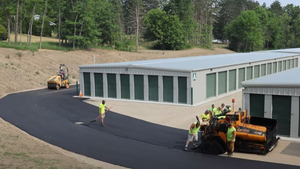The Magnificence of Multi-Story Self-Storage: Design to Guarantee a Successful Project
When developing self-storage on a small parcel, sometimes the only way to meet your investment goals is to build vertically. While multi-story projects can be challenging, they can also open the door to superior design. Learn the best time to consider this approach, requirements you’ll likely face, and ways to ensure a winning facility design.

Imagine being on the hunt for that ideal self-storage development opportunity. After searching and searching, a parcel is available to purchase. Everything about it aligns: The price is good, the market has low supply and high demand, rates are favorable, and there’s almost no competition nearby. However, there’s one catch: It’s less than an acre in size. With this, the only way to get to the target net rentable square footage is to build vertical.
For a novice self-storage developer or owner, this could feel a bit overwhelming. The following information will help you build an attractive, successful multi-story facility.
Is It Feasible?
There’s a higher cost to construct a self-storage facility that has more than one level, so it’s imperative to confirm that this route is financially feasible before purchasing the property. Below are a few key items to review during the due-diligence phase.
Parcel size. Typically, the main reason to build vertically is the land isn’t big enough to accommodate the necessary rentable square footage. That is, the only way to get to the target is to build up.
Market demand. As with any self-storage development, sufficient demand is critical. For a multi-story facility, there must be enough demand for climate-controlled units specifically.
Rates. With the increased cost of construction for multi-story, the market rates must be high enough to make the deal pencil out. If they’re too low, it’ll be difficult to justify the project.
Height restrictions. Each municipality allows a specific building height. For self-storage, each floor should have a minimum of 10 feet. Therefore, if the height restriction is 25 feet, the most levels you can build is two, unless there’s a basement.
Utilities. Multi-story facilities require water, sewer and electricity, so make sure the property has these available. Also, keep in mind that if the only water source is a well, you need to investigate whether there will be ample supply and pressure for the fire-suppression system.

The water tank for the fire-suppression system at Storage Kings in Bismarck, North Dakota
Required Features
Once you’ve determined that your multi-story self-storage project is feasible, you can shift focus to facility design. To begin, there are a few building features that are non-negotiable, as they relate to life safety. When working on the details for the following, lean on the expertise of your architect.
Elevators. Though these aren’t required by code, it’s an obvious feature that must be incorporated. The size of the building footprint and total rentable square footage will dictate the number of elevators needed and if they should be in more than one location. At a minimum, there should be one elevator near the main loading area.
Stairs. Having stairs in various locations is a safety requirement. In the case of a fire, people must have a way other than the elevator to get down from the upper levels. In warmer climates, some jurisdictions will allow the stairs to be on the outside of the building, which is ideal because they then don’t cut into the rental square footage. However, interior stairwells are necessary to have firewalls constructed of concrete-masonry unit (CMU) or fire-rated drywall. Your architect will determine the location and number of stairwells required.
Fire-suppression system. Its purpose is to quench a fire before it takes out the entire building and its contents. Your architect will work directly with a fire-sprinkler professional to create an acceptable design. However, there must be ample water and pressure to support this system. In some situations, water can be held in a pond that’s incorporated into the landscape or water tanks can be integrated into the plan.

The alcove loading/unloading area at StorQuest Self Storage in Tigard, Oregon
More Design Decisions
There are several other design elements that are common in multi-story self-storage facilities, and they directly impact the customer’s rental experience. Some of the ones listed below might not be required by code, however, the jurisdiction may demand them for aesthetic purposes.
Alcove loading areas. These are “indented” into the building. That is, vehicles park under part of the second floor as a covered area in which to load and unload. With this feature, it’s likely that underfloor insulation and metal soffit panels will need to be added.
Parapets. A parapet is an extension of an exterior wall that protrudes above the roof line. This can be included in a design purely for aesthetic reasons or it might be required. The main reason is to hide equipment on the roof.

Parapets and canopies on display at West Coast Self Storage in Lacey, Washington
Exterior canopies. These are attached to the building and often provide coverage from weather while tenants access exterior units. Sometimes they’re purely aesthetic.
Showcase units. Multi-story facilities will often showcase self-storage units on upper floors with large windows. They can be faux doors or actual rental units. In either case, the windows are large, the doors are brightly colored and there’s great lighting. The whole purpose is to gain the attention of people passing by.
Drive-thrus. These can be designed as a canopy at the main entrance or as a “tunnel.” In both cases, customers and their vehicles will be protected from the elements.
A canopy will be designed using structural steel. With a tunnel, the drive-thru goes through the first floor and under the second. It might be open on both ends, allowing air to flow freely from one side to the other. In some cases, there are overhead doors at either end, so any self-storage units along the tunnel can still be considered climate-controlled. A tunnel decreases your rentable square footage, however, it could be a significant selling point, depending on your area.

A mix of façade materials at Security Public Storage in Portland, Oregon
The Facade
The next major design decision when building multi-story self-storage is what materials to use on the façade, which might be driven by a combination of municipality requirements, budget or personal preference. Many class-A facilities use more than one type of material. Below are the three main options.
Metal panels (exposed and concealed fastening). These are made from light-gauge steel and formed into different profile shapes. They’re the most cost-effective option for an exterior finish. They come in myriad color options, with the screws exposed (completely visible) or concealed. To give a self-storage building a more unique design, the architect may mix up the orientation of the panels using more than one profile type and choose a few different colors.
Insulated metal panels (IMPs). These comprise foam insulation sandwiched between two metal panels, and there are multiple profiles and colors. One of the more common options has a stucco appearance. IMPs are often considered when the architect is looking for a specific look that can’t be achieved using standard panels or they need to get to a required R-value for building insulation.
Masonry. This category includes multiple options, including CMU block, stucco and brick. The architect might use CMU on the first floor to give the building a different look, but it’s also a part of the structural design.
Getting Across the Finish Line
Sometimes the only way to make a self-storage development work is to build vertically. Yes, it can be quite an undertaking. However, with the right knowledge and guidance, it can be done successfully.
Take time to fully analyze the parcel, the market and the municipality’s design requirements. If developing multi-story makes financial sense, then move on to choosing features and design elements. Keep in mind that everything discussed above should be done during the design phase with the right team.
Melissa Anderson is an account manager for Forge Building Co., which specializes in pre-engineered metal buildings for industrial and commercial applications. She has more than 20 years of experience in the construction industry. With an astute understanding of self-storage, she helps seasoned investors as well as those who are just beginning their journey with the construction of their first project. For more information, call 208.470.5368 or email [email protected].
About the Author(s)
You May Also Like







